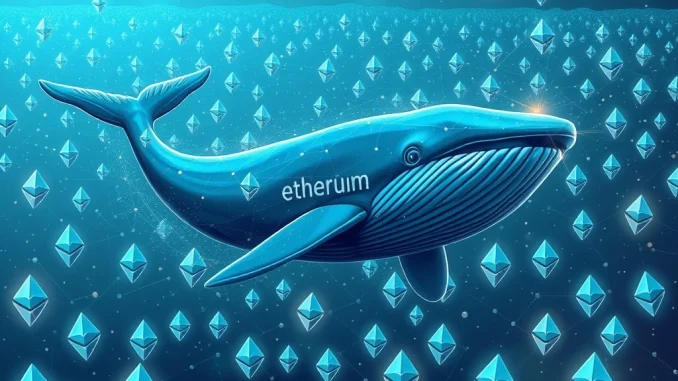
Are you ready to dive deep into the latest seismic shifts rocking the crypto world? Recent data paints a compelling picture: a monumental surge in Ethereum whale wallets is signaling an unprecedented wave of institutional capital pouring into the network. This isn’t just a ripple; it’s a tsunami of confidence in Ethereum’s future, reshaping the landscape for investors and enthusiasts alike.
Ethereum Whale Wallets: A Tidal Wave of Capital Unveiled
In the past 30 days, Ethereum’s blockchain has witnessed remarkable activity, marked by the emergence of 170 new “whale” wallets. What exactly constitutes a whale wallet? In this context, each of these new wallets holds over 10,000 ETH, representing a minimum of $30 million in value at current prices. Collectively, these inflows could total billions of dollars in fresh capital, indicating a robust long-term confidence in Ethereum’s ecosystem.
This trend is widely interpreted as a strong indicator of growing institutional interest in the asset class. Analysts frequently note that whale accumulation patterns often precede significant market movements, suggesting a bullish outlook for Ethereum. This isn’t just about large individual holders; it’s about sophisticated players making strategic long-term bets.
Institutional Ethereum Investment: Who’s Piling In and Why?
The accumulation of Ethereum aligns with broader shifts in the cryptocurrency landscape, as traditional finance (TradFi) increasingly recognizes the potential of blockchain technology. Ethereum’s pivotal role as the backbone of decentralized finance (DeFi), non-fungible tokens (NFTs), and Web3 applications has made it an irresistible target for strategic investments from major financial firms.
Recent on-chain data reveals that prominent institutional players, including BlackRock, Fidelity, and Bitwise, collectively added a substantial 588,000 ETH to their holdings in late June and early July 2025. This activity coincides with notable hiring trends, such as Ethereum-focused projects actively recruiting former BlackRock portfolio managers to lead investment strategies. This highlights a powerful convergence between traditional finance and the burgeoning blockchain ecosystem, bringing a new level of legitimacy and capital to the space.
What’s Driving the ETH Price Surge Amidst Market Dynamics?
Ethereum’s institutional appeal is further bolstered by ongoing regulatory progress and continuous technical upgrades. Scaling solutions like layer-2 networks and infrastructure enhancements have significantly strengthened its position as a foundational asset in the digital economy. These improvements address past concerns about network scalability and transaction costs, making Ethereum a more attractive and viable platform for large-scale operations.
Analysts point to validator exit queue dynamics and elevated whale activity as clear signs of strategic positioning, even amidst short-term market corrections. While Ethereum’s price peaked in July 2025 before experiencing a modest 7% decline, the shrinking supply of ETH combined with rising on-chain demand suggests sustained bullish sentiment. Prominent crypto analysts, like Mike Novogratz, have even predicted that Ethereum could outperform Bitcoin due to this escalating institutional demand, though such forecasts remain speculative.
The market’s reaction to these developments has been mixed. A 50% surge past key resistance levels has intensified speculation about an emerging bull cycle. However, some experts caution that recent gains may reflect a period of consolidation rather than an immediate breakout phase. Understanding these nuances is crucial for navigating the market.
Ethereum’s Role in Accelerating DeFi Growth and Stability
The influx of capital, particularly from whales, plays a crucial role in bolstering DeFi growth. Whale activity, including validator staking and deployments within various DeFi protocols, is seen as a significant stabilizing force for ETH’s price floor. By locking up substantial amounts of ETH in staking or liquidity pools, these large holders reduce the circulating supply and demonstrate long-term commitment to the network’s health and security.
This stability, in turn, helps attract both retail and professional investors who are looking for more reliable entry points into the volatile crypto market. Ethereum’s robust DeFi ecosystem, with its myriad of lending, borrowing, and trading platforms, provides ample opportunities for these institutional funds to be deployed, further integrating Ethereum into the global financial fabric.
Navigating Broader Crypto Market Trends: Opportunities and Challenges
While the overall sentiment around Ethereum is overwhelmingly positive, it’s important to acknowledge the inherent volatility within the broader crypto market trends. For instance, BloomingBit reported $170 million in Ethereum short positions, though it’s critical to note that this data pertains to derivatives trading and does not directly contradict the underlying whale accumulation trend, which focuses on spot holdings.
The influx of capital underscores Ethereum’s evolving role beyond a mere digital asset. Its deep integration into DeFi platforms and Web3 infrastructure, coupled with validator-led network upgrades, positions it as a critical component of the next internet era. Institutional investors are increasingly viewing ETH as a strategic, foundational asset, with whale accumulation signaling a transition toward long-term value retention rather than purely speculative trading.
In conclusion, the emergence of Ethereum whale wallets and the subsequent billions in institutional Ethereum investment paint a clear picture: smart money is making a decisive move into the Ethereum ecosystem. This profound shift, driven by regulatory clarity, technical advancements, and Ethereum’s central role in DeFi growth, is poised to have a lasting impact on ETH price surge dynamics and broader crypto market trends. While volatility remains a factor, the long-term outlook for Ethereum, buoyed by this institutional confidence, appears remarkably strong, signaling a new era of mainstream adoption and integration.
Frequently Asked Questions (FAQs)
What is an Ethereum whale wallet?
An Ethereum whale wallet refers to a cryptocurrency address holding a very large amount of Ethereum (ETH). In the context of this article, it specifically refers to wallets holding over 10,000 ETH, which translates to tens of millions of dollars in value, indicating a significant investor.
How much institutional money is flowing into Ethereum?
Recent data indicates that 170 new whale wallets have emerged, each holding over 10,000 ETH. This suggests billions of dollars in fresh institutional capital inflows. Major firms like BlackRock, Fidelity, and Bitwise alone added 588,000 ETH to their holdings recently.
Why are institutions investing so heavily in Ethereum?
Institutions are drawn to Ethereum due to its foundational role in decentralized finance (DeFi), NFTs, and Web3 applications. Improved scalability solutions, regulatory progress, and its status as a critical infrastructure for the next internet era make it a strategic long-term investment.
Will Ethereum’s price increase significantly due to these inflows?
While past whale accumulation often precedes significant market movements, and analysts like Mike Novogratz predict ETH could outperform Bitcoin, market reactions can be mixed. The shrinking supply and rising on-chain demand suggest bullish sentiment, but short-term volatility persists. These inflows primarily signal long-term confidence rather than immediate price spikes.
What is the role of DeFi in Ethereum’s institutional appeal?
DeFi is a major driver of institutional interest. Whales often engage in validator staking and deploy capital within DeFi protocols, which helps stabilize ETH’s price floor by reducing circulating supply. This integration makes Ethereum a more attractive and robust asset for both professional and retail investors.



